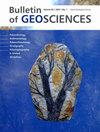New data on conodonts and ostracods of the Katkoyeh Formation (Lower-Upper Ordovician) at the Banestan Section of East-Central Iran: biostratigraphical and palaeobiogeographical significance
IF 1.5
3区 地球科学
Q3 GEOSCIENCES, MULTIDISCIPLINARY
引用次数: 1
Abstract
Ordovician marine sedimentary sequences occur in several widely separated structural blocks in Iran, along the northern margin of Gondwana. In northern Kerman Province, the Ordovician sedimentary interval is known as the Katkoyeh Formation, which encompasses ~ 70–300 m of siliciclastic rocks with scarce carbonate and thick pyroclastic beds in its upper part. Previous studies provided several ages for the Katkoyeh Formation, puzzled by the limited number of palaeontological studies, mostly based on spot samples, the presence of regional important stratigraphic gaps, and the inherent structural complexity of the area. In order to adjust the depositional time of the Katkoyeh Formation, a systematic sampling for microfossils was conducted in the Banestan Section, located about 12 km northwest of the city of Zarand, in the vicinity of the Banestan village. Based on the occurrence of important biostratigraphic species, we recorded three conodont intervals in ascending order in the Katkoyeh Formation, namely the Rossodus manitouensis/ Paltodus deltifer Concurrent Range Zone (Tremadocian, Lower Ordovician), the Juanognathus variabilis Range Zone (Floian, Lower Ordovician), and the Icriodella superba Range Zone (Katian–?Hirnantian, Upper Ordovician). The conodont biostratigraphy is discussed and analysed, improving the Ordovician intrabasinal correlation of Iran as well as correlation with distant palaeobiogeographic domains. The Upper Ordovician conodont assemblage is accompanied by two new species of ostracods: Satiellina zarandensis sp. nov. and Ceratopsis persicus sp. nov., both suggesting palaeobiogeographical affinities mainly with Gondwana and peri-Gondwanan regions. •伊朗中东部Banestan段Katkoyeh组(下-上奥陶统)牙形刺和介形虫的新资料:生物地层学和古生物地理学意义
奥陶系海相沉积层序分布在伊朗冈瓦纳北缘几个相距较远的构造块体中。在Kerman省北部,奥陶系沉积层段被称为Katkoyeh组,该层段包括~ 70 ~ 300 m的硅质碎屑岩,上部碳酸盐稀缺,火山碎屑层厚。以前的研究提供了Katkoyeh组的几个年龄,但由于古生物学研究数量有限,主要基于现场样本,区域重要地层间隙的存在以及该地区固有结构的复杂性,这些研究令人困惑。为了调整Katkoyeh组的沉积时间,在Banestan剖面进行了系统的微化石采样,该剖面位于Zarand市西北约12公里处,位于Banestan村附近。根据重要生物地层物种的产状,我们在Katkoyeh组记录了3个牙形刺层序,即Rossodus manitouensis/ Paltodus deltifer Concurrent Range Zone (Tremadocian,下奥陶统)、Juanognathus variabilis Range Zone (Floian,下奥陶统)和Icriodella superba Range Zone (Katian - ?Hirnantian,上奥陶统)。对牙形石生物地层学进行了讨论和分析,提高了伊朗奥陶系基底内对比以及与遥远古地理域的对比。上奥陶统牙形石组合中还发现了两种新的甲壳类动物:Satiellina zarandensis sp. nov和Ceratopsis persicus sp. nov,这两种甲壳类动物在古地理上主要与冈瓦纳和冈瓦纳周边地区有亲缘关系。•
本文章由计算机程序翻译,如有差异,请以英文原文为准。
求助全文
约1分钟内获得全文
求助全文
来源期刊

Bulletin of Geosciences
地学-地球科学综合
CiteScore
3.10
自引率
5.30%
发文量
18
审稿时长
>12 weeks
期刊介绍:
The Bulletin of Geosciences is an international journal publishing original research papers, review articles, and short contributions concerning palaeoenvironmental geology, including palaeontology, stratigraphy, sedimentology, palaeogeography, palaeoecology, palaeoclimatology, geochemistry, mineralogy, geophysics, and related fields. All papers are subject to international peer review, and acceptance is based on quality alone.
 求助内容:
求助内容: 应助结果提醒方式:
应助结果提醒方式:


